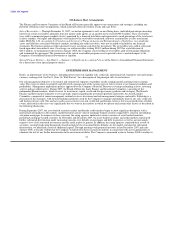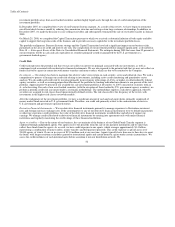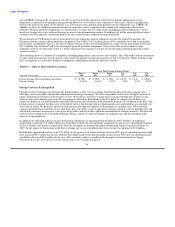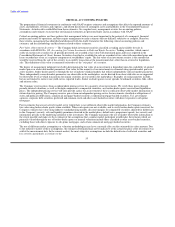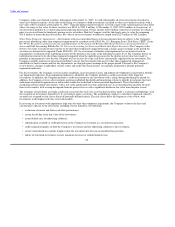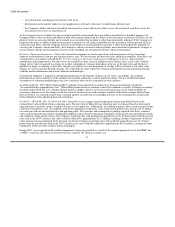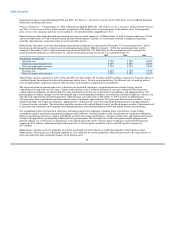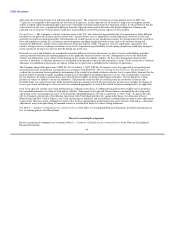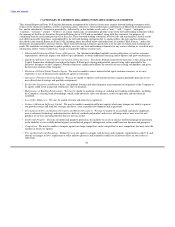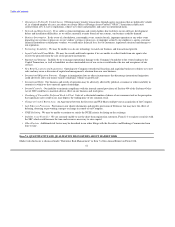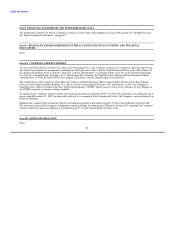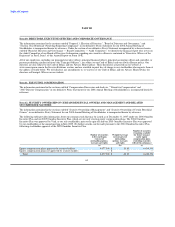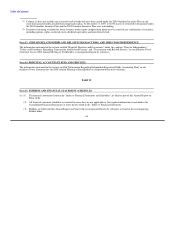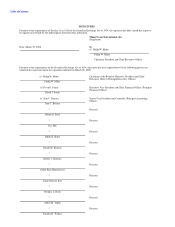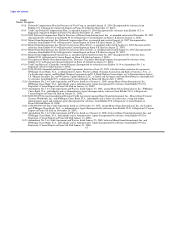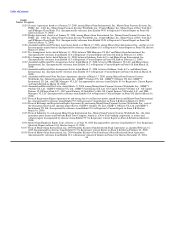MoneyGram 2007 Annual Report Download - page 62
Download and view the complete annual report
Please find page 62 of the 2007 MoneyGram annual report below. You can navigate through the pages in the report by either clicking on the pages listed below, or by using the keyword search tool below to find specific information within the annual report.
Table of Contents
allocation, the investing strategy or in inflation and interest rates. The actual rate of return on average pension assets in 2007 was
7.1 percent, as compared to the expected rate of return of 8.0 percent. As the expected rate of return is a long-term assumption and the
widely accepted capital market principle is that assets with higher volatility generate greater long-term returns, we do not believe that the
actual return for one year is significantly different from the expected return used to determine the benefit obligation. Changing the
expected rate of return by 50 basis points would have increased/decreased 2007 pension expense by $0.6 million.
Income Taxes — The Company is subject to income taxes in the U.S. and various foreign jurisdictions. Our operations in these different
jurisdictions are generally taxed on income before taxes. Income before taxes is adjusted for various differences between tax law and
generally accepted accounting principles. Determination of taxable income in any jurisdiction requires the interpretation of the related tax
laws and regulations and the use of estimates and assumptions regarding significant future events such as the amount, timing and
character of deductions, and the sources and character of income and tax credits. Changes in tax laws, regulations, agreements and
treaties, foreign currency exchange restrictions or our level of operations or profitability in each taxing jurisdiction could have an impact
on the amount of income taxes that we provide during any given year.
Deferred tax assets and liabilities are recorded based on the difference between the income tax basis of assets and liabilities and their
carrying amounts for financial reporting purposes at the applicable enacted statutory tax rates. Management assesses the likelihood
whether net deferred tax assets will be realized based on the weight of available evidence. To the extent management believes that
recovery is not likely, a valuation allowance is established in the period in which the determination is made. To the extent that a valuation
allowance is established or increased, an expense within the tax provision is included in the statement of operations.
The Company adopted the provisions of FIN No. 48, on January 1, 2007. FIN No. 48 requires a two-step approach to recognizing and
measuring uncertain tax positions accounted for in accordance with SFAS No. 109, Accounting for Income Taxes. The first step is to
evaluate the tax position for recognition by determining if the weight of available evidence indicates that it is more likely than not that the
position will be sustained on audit, including resolution of related appeals or litigation processes, if any. The second step is to measure
the tax benefit as the largest amount that is more than 50 percent likely of being realized upon settlement. Our tax filings for various
periods are subject to audit by various tax authorities. The potential exists that the tax resulting from the resolution of current and
potential future tax controversies may differ materially from the amount accrued. The provision for income taxes includes the impact of
reserve provisions and changes to reserves that are considered appropriate, as well as the related net interest and penalties, as applicable.
Prior to the spin-off, income taxes were determined on a separate return basis as if MoneyGram had not been eligible to be included in
the consolidated income tax return of Viad and its affiliates. Subsequent to the spin-off, MoneyGram is considered the divesting entity
and treated as the "accounting successor" to Viad and the continuing business of Viad is referred to as "New Viad." As part of the spin-
off, the Company entered into a Tax Sharing Agreement with Viad which provides for, among other things, the allocation between
MoneyGram and New Viad of federal, state, local and foreign tax liabilities and tax liabilities resulting from the audit or other adjustment
to previously filed tax returns. Although we believe that we have appropriately proportioned such taxes between Viad and us, subsequent
adjustments may occur upon filing of amended returns or resolution of audits by various taxing authorities.
See Note 2 — Summary of Significant Accounting Policies of the Notes to Consolidated Financial Statements for further information on
key accounting policies for MoneyGram.
Recent Accounting Developments
Recent accounting developments are set forth in Note 2 — Summary of Significant Accounting Policies of the Notes to Consolidated
Financial Statements.
59




